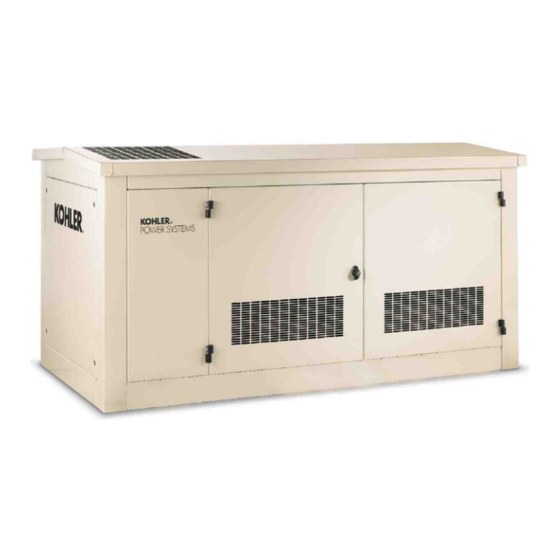Kohler 30RES Manuale - Pagina 26
Sfoglia online o scarica il pdf Manuale per Generatore portatile Kohler 30RES. Kohler 30RES 36. Residential generator sets

Battery short circuits. Explosion can cause severe injury
or death.
Short circuits can cause bodily injury and/or
equipment damage. Disconnect the battery before generator
set installation or maintenance. Remove all jewelry before
servicing the equipment. Use tools with insulated handles.
Remove the negative (--) lead first when disconnecting the
battery.
Reconnect the negative (--) lead last when
reconnecting the battery. Never connect the negative (--)
battery cable to the positive (+) connection terminal of the
starter solenoid. Do not test the battery condition by shorting
the terminals together.
3.10 Ignition System
Service the spark plugs at the interval specified in the
service schedule using the following procedure.
Spark Plug Service Procedure
1. Place the generator set master switch in the OFF
position.
2. Disconnect the power to the battery charger, if
equipped.
Problem/Condition
Means of Identification
Gap-bridged spark
Built-up deposits and gap between electrodes
plug
closing.
Oil-fouled spark plug
Wet, black deposits on the insulator shell, bore,
and electrodes.
Carbon-fouled spark
Black, dry, fluffy carbon deposits on insulator
plug
tips, exposed shell surfaces and electrodes.
Lead-fouled spark plug Dark gray, black, yellow, or tan deposits; or a
glazed coating on the insulator tip.
Pre-ignition damaged
Melted electrodes and possibly blistered
spark plug
insulator. Metallic deposits on insulator suggest
internal engine damage.
Overheated spark plug White or light gray insulator with small black or
gray/brown spots with bluish (burned)
appearance on electrodes.
Worn spark plug
Severely eroded or worn electrodes.
Figure 3-9 Engine Evaluation Using Spark Plug Condition
26
Section 3 Scheduled Maintenance
3. Disconnect the generator set engine starting
battery, negative (--) lead first.
4. Remove spark plug wires by grasping the spark
plug boot and turning slightly while pulling. Do not
pull the wire. Pulling on the wire rather than the
boot may damage the wire or terminal.
5. Loosen the spark plug with a ratchet and 5/8-in.
spark plug socket with a rubber insert to prevent
spark plug damage.
6. Use compressed air to remove dirt from around
each spark plug to prevent dirt particles from falling
into the combustion chamber.
7. Remove spark plugs, one at a time, and examine.
Identify a normal spark plug in good operating
condition by observing a light tan or gray deposit on
firing tip.
See Figure 3-9 to evaluate engine
condition by color/condition of a problem spark plug.
Possible Cause/Solution
Oil or carbon fouling. Clean and regap the spark
plug.
Excessive oil entering combustion chamber
through worn rings and pistons, excessive
clearance between valve guides and stems, or
worn or loose bearings. Replace the spark plug.
Incorrect spark plug, weak ignition, clogged air
intake, overrich fuel mixture, or excessive
no-load operation. Clean and regap the spark
plug.
Caused by highly leaded fuel. Replace the
spark plug.
Wrong type of fuel, incorrect timing or advance,
too hot a plug, burned valves, or engine
overheating. Replace the spark plug.
Engine overheating, wrong type of fuel, loose
spark plugs, too hot a plug, low fuel pressure or
incorrect ignition timing. Replace the spark plug.
Caused by normal wear and failure to replace
spark plug at prescribed interval. Replace the
spark plug.
TP-6344 4/09
